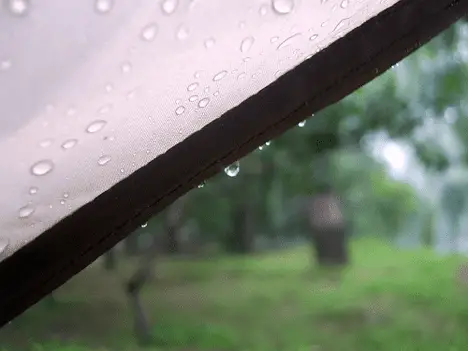Have you ever woken up in the morning after a night sleeping in your tent and asked yourself, “why is the inside of my tent wet?” You are not alone. Partly because I have wondered the same thing, so there are at least two of us. Surprisingly, it is actually quite a common problem.
In this post, I will explore the reason why the inside of your tent is wet and also what you can do to prevent it.
If you’re in a hurry:
The most common cause of the inside of your tent being wet is down to condensation. This is because of the warm air inside the tent meeting with the cool fabric of your tent causing the moisture in the air to condense into a liquid. However, you can’t fully rule out a leak until you have investigated.
Find out below how to tell the difference and what you can do to help prevent it.
Condensation vs. Leak

Ok, so you’ve found some water in your tent. You’ve either found water on the inner flysheet of the tent or you have a puddle on the tent. I found out my tent was leaking once by stepping in a puddle, yuk!
At this point, it is important to work out whether there is water in your tent because there is a leak in the tent or it is just a result of condensation.
Let’s tackle each of these one by one and see if we can work out what the problem is with your tent.
How do I know if my tent is leaking?
When the inside of your tent is wet, this is not necessarily a sign that you have a leak. In fact, more often than not it is a result of condensation. However, you shouldn’t just assume that it is condensation as you might soon find out the hard way that it is, in fact, a leak.
Think torrential rain and major leakage!
Where is my tent most likely to leak?
There are two main areas that you will need to test to make sure your tent isn’t leaking:
- The seams of your tent
- The outer layer of your tent
Testing for leaks
To check to see if your tent is leaking is actually quite a simple process. If you have any little helpers around this is the ideal time to call upon them.
To test the tent, simply put the tent up and then get it wet.
My preferred method is to use a hose set to a light spray and cover the whole tent with water. This is the fun bit that kids will love to help with. Just make sure you remind them that you are testing if there are any leaks, not checking to see if the tent can withstand the full force of a waterfall!
Once you have the tent adequately wet, go inside and see if you can see any water coming in.
No water, no leak!
If you do have water, see if it is coming through the outer layer of the tent or the seams. Where the water is coming through will help determine how to repair it.
How to fix a leaking tent
I cover how to fix a leaking tent in more detail in my How to Waterproof a Tent guide. If you would like to know the basic of what to do:
- Clean the seams with rubbing alcohol
- Apply seam sealer to the tent
- Spray your water repellent onto the outside of the tent
- Wipe off any excess repellent
- Leave to dry
- Check that it has worked
How do I know if it is condensation?
If you have tested your tent for leaks and found there is nothing coming through the tent, the chances are that the moisture inside the tent is condensation.
What causes condensation inside a tent?

Condensation forms when the warm air from inside your tent meets with the cool material of the outer layer of your tent. Any moisture in the air inside your tent will then form into a liquid on the inside of the tent as the air quickly cools on the outer layer.
Condensation can even form in the summer months of the year. The air outside your tent can be as low as 10 degrees Celsius in the nighttime in the UK and a tent is typically somewhere between 5-10 degrees warmer on the inside than the outside of the tent.
Other weather conditions can cause condensation inside your tent. On rainy days, when the water evaporates off the surface of the tent, this dramatically lowers the temperature of the material, similar to how sweat cools you down. As mentioned above, this cooler material will help the forming of condensation inside your tent.
How to deal with condensation in my tent?
One of the easiest ways to deal with condensation inside your tent is to wipe it off with a towel. This will stop the water from dripping onto your groundsheet or your tent inner, depending on the type of tent you have.
If you have a polycotton tent, DON’T wipe the inside of the tent as you will encourage the water from the outside to seep through the material.
If you need to pack your tent up before it can fully dry, this is fine. On particularly cool days it can take quite a while for your tent to warm up and dry out naturally. It is advisable to simply pack up and then put your tent up again when the weather is warmer, such as midday or early afternoon.
How to prevent condensation in a tent

Avoid touch the sides of your tent
Touching the sides of the tent can make it easier for the moisture on the outside to seep through.
You should also make sure not to put items against the wall of the tent as this also helps the water to come through, especially with a polycotton tent.
Ventilate your tent properly
Tents are built with fantastic ventilation that should help prevent moisture from building up on the inside of your tent.
Weather permitting, you should leave the vents on doors and windows open as much as possible to allow the air to flow through the tent and help reduce the moisture in there.
Also, try to avoid putting items in front of vents to give them the maximum efficiency for reducing condensation in your tent.
Store wet things outside
If you’re asking yourself, why is the inside of my tent wet, whilst storing all your wet things inside the tent, then you probably have your answer right there.
As wet clothes and towels dry out they will add to the moisture in the air of the tent and therefore increase the likelihood of condensation.
Drying items outside of the tent is the ideal solution here. If you are unable to dry them outside, but have spare items and don’t really need them for the rest of your trip, try storing them in a sealed bag.
Turn off heaters when not in use
If you are using a heated inside the tent, this is also increasing the chances of the inside of your tent being wet.
As discussed earlier, condensation is created from the warm air hitting against the cold surface of the tent material. Increasing the temperature inside your tent will increase the difference in temperature between the inside and outside of the tent and lead to more condensation forming.
Rather than heat the air inside the tent, look for other ways to stay warm inside your tent, such as blankets in sleeping bags or putting more layers on.
Don’t cook inside your tent
Cooking inside your tent will have a similar effect as using a heater. You are warming the air inside your tent and therefore increasing the difference between temperatures inside and outside the tent.
In addition to the heat, there is also the moisture from what you are cooking to consider. This will increase the moisture in the air of your tent and simply add to the amount of condensation you end up with as a result.
Also cooking in your tent is dangerous, so be careful.
Take spare towels
Make sure you take spare towels with you for your trip as this can help reduce the chances of the inside of your tent getting wet.
The first reason for this is that the wet, used towels inside your tent will add to the moisture (see the section above about storing wet things outside)
Spare towels can also be used to help dry the inside of the tent if it is particularly wet inside.
Pitch your tent somewhere with a breeze
The final point here is to try and pitch somewhere that has a breeze.
Allowing the air to flow through your tent will increase the effectiveness of the vents in removing the moist air inside.
Just make sure you don’t pitch up in a wind tunnel!
Conclusion
So, why is the inside of my tent wet? The chances are it is just condensation, but please check that is definitely the case as you don’t want to find out during the middle of a storm that it is actually leaking!


